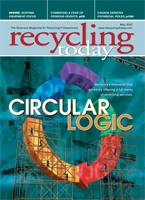UNCERTAIN TIMES
The uncharacteristically strong recovered fiber markets enjoyed during the first quarter of 2007 have shifted into some uncertainty and pricing conflicts at the beginning of the second quarter.
Prices for the recovered fiber market’s power grade, old corrugated containers (OCC), skyrocketed in the early months of the year, leading some to fear a steep drop in coming months. While OCC is still fetching a higher-than-average price, sources say the pricing structure for the grade is causing a great deal of conflict, particularly in the Midwest in what one Midwestern recycler calls a "disheveled market."
The published price dropped by $10 at the beginning of April, which wasn’t enough for some mills, according to several Midwestern sources. While there is always some regional variation between the listed prices and what material is actually bought and sold at, this month, mills are dropping their prices at nearly double the rate, $20 down compared to the published $10 decline in some areas, according to a Midwestern recycler.
"People are paying all kinds of different amounts for OCC—it’s varying everywhere," says one Midwestern packer. "[Published pricing] is overstated, so [mills] are just kind of holding ground and doing their own thing."
The conditions don’t make for a sunny spring outlook for packers and brokers, according to a Midwestern recycler. "There will be a lot of people caught in the squeeze when they have to pay their customers," he says, describing the current conditions as a "profitless market." He says, "We’re going to do a lot of tons that just break even this month."
Prices for old newspapers (ONP) also fell $10 this month, but that market isn’t experiencing the same level of conflict between listed price and what the mills will actually pay. The grade has enjoyed relative stability, but some sources question its long-term strength. Declining readership and thinning newspapers are both signs of trouble for newsprint demand in the long term. In addition, the declining domestic housing market is also troublesome. As the housing market continues its cool streak, insulators who consume ONP for their product also suffer.
Another long-term issue on the minds of paper recyclers is collection, particularly of OCC. One Southwestern recycler says that at 75 percent, the recycling rate of OCC is approaching the point where any increase would come with a sizable increase in expense. "It would be costing more to recover more," he says. "Is the expense worth it?"
Transportation also remains an issue as high gas prices continue to chip away at margins. However, at this point, many are simply beginning to accept high transportation costs as simply a part of doing business, unwelcome as it may be.
(Additional news about paper recycling markets, including breaking news and pricing, is available online at www.RecyclingToday.com.)
VISY TO GO FORWARD WITH EXPANSION
Visy has announced that it has decided to go ahead with an expansion project at its Tumut New South Wales Pulp and Paper mill in Australia.
When completed, the expansion should more than double the mill’s current output of kraft paper to around 700,000 metric tons per year. Construction is expected to take around 18 months and it is hoped to be operational by 2009.
The company also is undertaking a feasibility study into a possible $300 million plus expansion at its Smithfield packaging and recycling facility in Sydney, Australia.
The study would examine the case for a new paper recycling machine to improve Visy Paper’s quality and cost competitiveness as well as add to the company’s existing recycled paper making capacity.

Explore the May 2007 Issue
Check out more from this issue and find your next story to read.
Latest from Recycling Today
- Nucor receives West Virginia funding assist
- Ferrous market ends 2024 in familiar rut
- Aqua Metals secures $1.5M loan, reports operational strides
- AF&PA urges veto of NY bill
- Aluminum Association includes recycling among 2025 policy priorities
- AISI applauds waterways spending bill
- Lux Research questions hydrogen’s transportation role
- Sonoco selling thermoformed, flexible packaging business to Toppan for $1.8B





